| Article ID | Journal | Published Year | Pages | File Type |
|---|---|---|---|---|
| 8866414 | Remote Sensing of Environment | 2018 | 17 Pages |
Abstract
One of the most common approaches to reducing the environmental impact of nitrogen (N) fertilisation in intensive agrosystems is to adjust the N input of the crop requirement. This adjustment is frequently related to the nitrogen nutrition index (NNI) based on the concepts of the critical and actual N absorbed (kg/ha) in the crop canopy (respectively, NC and CNC). Accurate estimation of the NC and CNC at the field scale over large areas based on freely available satellite imagery is thus a key issue to address. Relying on a large dataset of farmers' fields, this study highlights the high correlation (R2â¯=â¯0.90) between the wheat CNC and canopy chlorophyll content (CCC) retrieved from Sentinel-2 (S2) with an Artificial Neural Network (ANN). The estimation is related to errors of 4 and 21â¯kg/ha (depending on the growing stage), which is a promising result for evaluating the NNI. There are four major outcomes from this result: (i) the importance of working at the canopy level; (ii) the independence of the relationship to the considered cultivars; (iii) the dependence of the relationship on the growing stage; and (iv) the potential to use only the 10â¯mâ¯S2 bands, opening the way for precision agriculture. In parallel, estimation accuracies were investigated for the three biophysical variables (BV) related to the CNC and NC, i.e., the green area index (GAI), leaf chlorophyll content (Cab) and CCC. From this analysis, the added value of the red-edge bands for improving the estimation of the 3 BVs of interest was quantified as was the performance reduction related to the field heterogeneity.
Related Topics
Physical Sciences and Engineering
Earth and Planetary Sciences
Computers in Earth Sciences
Authors
Cindy Delloye, Marie Weiss, Pierre Defourny,
